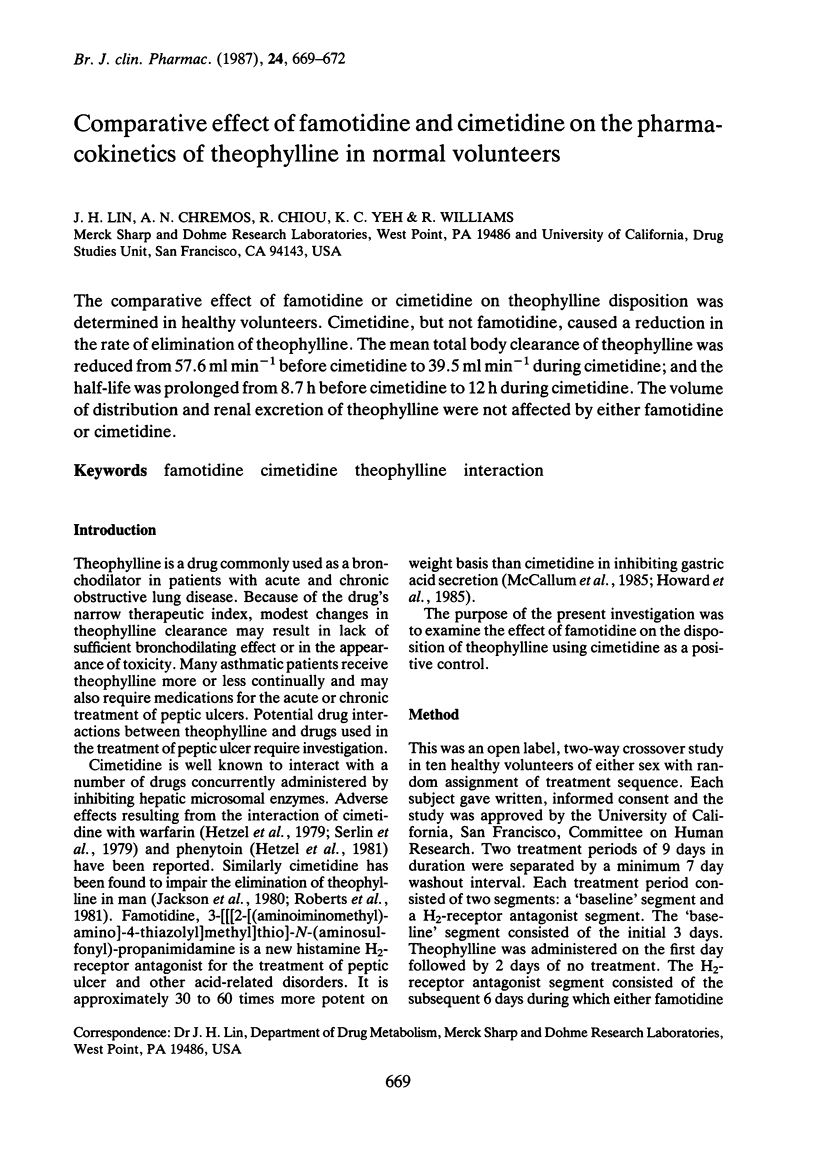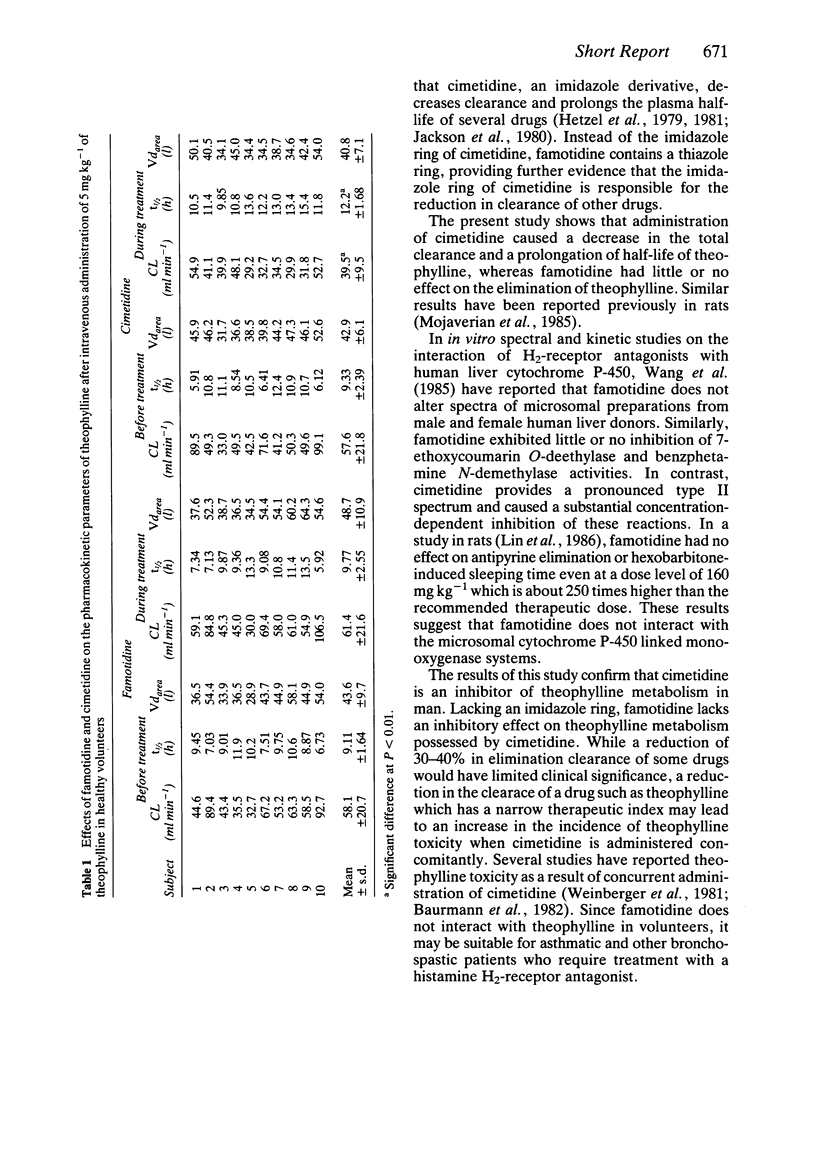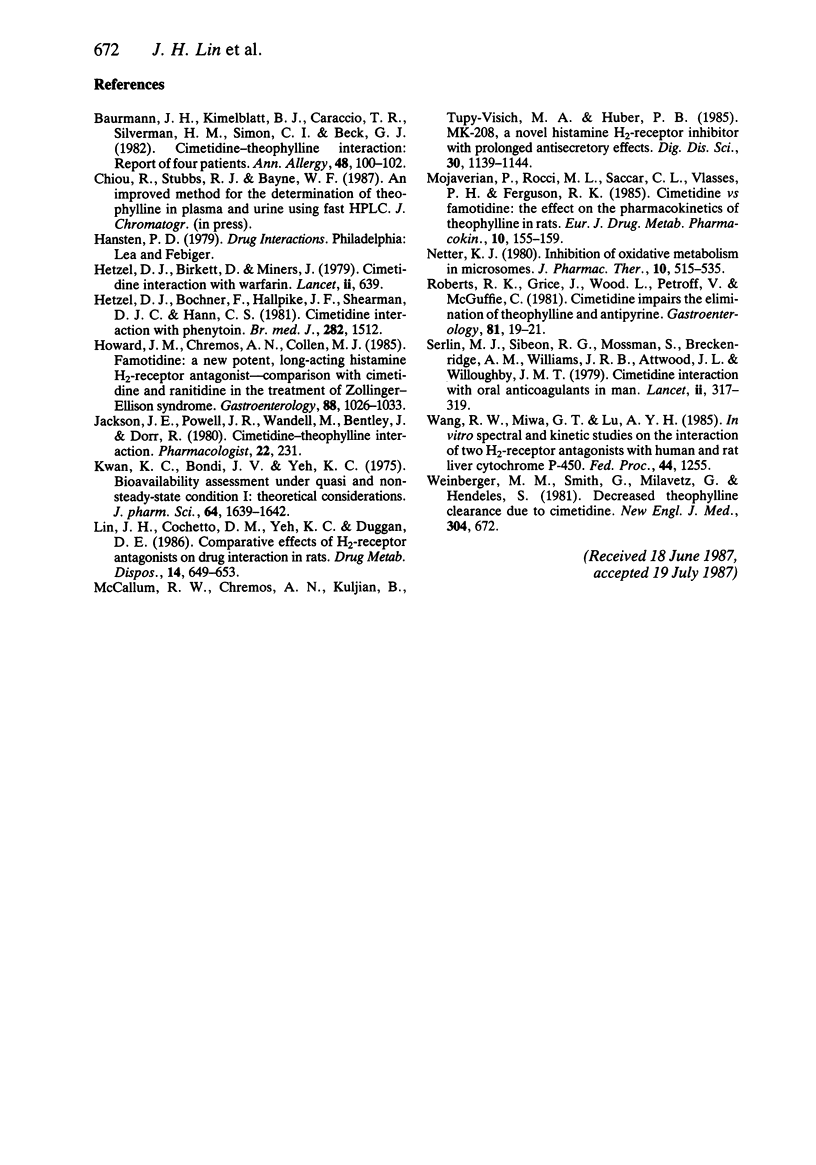Abstract
The comparative effect of famotidine or cimetidine on theophylline disposition was determined in healthy volunteers. Cimetidine, but not famotidine, caused a reduction in the rate of elimination of theophylline. The mean total body clearance of theophylline was reduced from 57.6 ml min-1 before cimetidine to 39.5 ml min-1 during cimetidine; and the half-life was prolonged from 8.7 h before cimetidine to 12 h during cimetidine. The volume of distribution and renal excretion of theophylline were not affected by either famotidine or cimetidine.
Full text
PDF



Selected References
These references are in PubMed. This may not be the complete list of references from this article.
- Bauman J. H., Kimelblatt B. J., Caraccio T. R., Silverman H. M., Simon G. I., Beck G. J. Cimetidine-theophylline interaction: report of four patients. Ann Allergy. 1982 Feb;48(2):100–102. [PubMed] [Google Scholar]
- Hetzel D. J., Bochner F., Hallpike J. F., Shearman D. J., Hann C. S. Cimetidine interaction with phenytoin. Br Med J (Clin Res Ed) 1981 May 9;282(6275):1512–1512. doi: 10.1136/bmj.282.6275.1512. [DOI] [PMC free article] [PubMed] [Google Scholar]
- Hetzel D., Birkett D., Miners J. Cimetidine interaction with warfarin. Lancet. 1979 Sep 22;2(8143):639–639. doi: 10.1016/s0140-6736(79)91701-x. [DOI] [PubMed] [Google Scholar]
- Howard J. M., Chremos A. N., Collen M. J., McArthur K. E., Cherner J. A., Maton P. N., Ciarleglio C. A., Cornelius M. J., Gardner J. D., Jensen R. T. Famotidine, a new, potent, long-acting histamine H2-receptor antagonist: comparison with cimetidine and ranitidine in the treatment of Zollinger-Ellison syndrome. Gastroenterology. 1985 Apr;88(4):1026–1033. doi: 10.1016/s0016-5085(85)80024-x. [DOI] [PubMed] [Google Scholar]
- Kwan K. C., Bondi J. V., Yeh K. C. Bioavailability assessment under quasi- and nonsteady-state conditions. I: theoretical considerations. J Pharm Sci. 1975 Oct;64(10):1639–1642. doi: 10.1002/jps.2600641010. [DOI] [PubMed] [Google Scholar]
- Lin J. H., Cocchetto D. M., Yeh K. C., Duggan D. E. Comparative effects of H2-receptor antagonists on drug interaction in rats. Drug Metab Dispos. 1986 Nov-Dec;14(6):649–653. [PubMed] [Google Scholar]
- McCallum R. W., Chremos A. N., Kuljian B., Tupy-Visich M. A., Huber P. B. MK-208, a novel histamine H2-receptor inhibitor with prolonged antisecretory effect. Dig Dis Sci. 1985 Dec;30(12):1139–1144. doi: 10.1007/BF01314047. [DOI] [PubMed] [Google Scholar]
- Mojaverian P., Rocci M. L., Jr, Saccar C. L., Vlasses P. H., Ferguson R. K. Cimetidine versus famotidine: the effect on the pharmacokinetics of theophylline in rats. Eur J Drug Metab Pharmacokinet. 1985 Apr-Jun;10(2):155–159. doi: 10.1007/BF03189710. [DOI] [PubMed] [Google Scholar]
- Netter K. J. Inhibition of oxidative drug metabolism in microsomes. Pharmacol Ther. 1980;10(3):515–535. doi: 10.1016/0163-7258(80)90029-7. [DOI] [PubMed] [Google Scholar]
- Roberts R. K., Grice J., Wood L., Petroff V., McGuffie C. Cimetidine impairs the elimination of theophylline and antipyrine. Gastroenterology. 1981 Jul;81(1):19–21. [PubMed] [Google Scholar]
- Serlin M. J., Sibeon R. G., Mossman S., Breckenridge A. M., Williams J. R., Atwood J. L., Willoughby J. M. Cimetidine: interaction with oral anticoagulants in man. Lancet. 1979 Aug 18;2(8138):317–319. doi: 10.1016/s0140-6736(79)90340-4. [DOI] [PubMed] [Google Scholar]
- Weinberger M. M., Smith G., Milavetz G., Hendeles L. Decreased clearance of theophylline due to cimetidine. N Engl J Med. 1981 Mar 12;304(11):672–672. doi: 10.1056/nejm198103123041117. [DOI] [PubMed] [Google Scholar]


